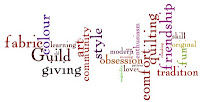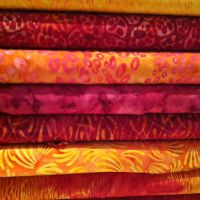Balance consists of the visual weight given to the objects in the design. It can be either symmetrical or asymmetrical.
 |
| Horizontal and vertical symmetrical balance |
Approximate vertical symmetry occurs when there is symmetry because both sides are similar but not identical. This quilt has approximate vertical symmetry because the smaller rectangles have different widths but end up taking the amount of area.
Radial symmetry occurs when the objects are symmetrical around a centre point. The centre of this Dresden Plate block has radial symmetry. The rest of the block, outside of the centre, has vertical and horizontal symmetry.
 |
| Approximate vertical symmetry |
 |
| Radial symmetry |
 |
| Asymmetrical |
A design is asymmetrical when the visual weight of an object is not evenly distributed. This design often has a dominant form that is offset by other, smaller forms. This creates visual tention. The Christmas hanging to the right is asymmetrical. The bells are the dominant forms.
Rhythm is attained through the repetition or regular change of elements. When elements have defined space between them, this often creates a sense of movement.
Regular rhythm occurs when the objects and the space between them are similar in length or size. This Christmas runner is both symmetrical and has rhythm.
 |
| Symmetry and rhythm |
A flowing rhythm achieves a sense of movement. This wall hanging has a sense of movement about it, especially through its wavy horizontal lines at the top.
A progressive rhythm occurs when a sequence of forms go through a progression of steps. This block is a card trick block. It has progressive rhythm as the cards progress into a circle.
Proportion is the relationship in scale between the objects of a design. Adding elements of different proportions can give a design weight and depth.
Within a design, dominance is the amount of emphasis or visual weight that an element receives.
 |
| Flower Show Quilts |
A dominant element will have the most visual weight.
The sub-dominant element will have secondary emphasis - usually found in the middle-ground of the design.
The subordinate element will have the least amount of visual weight and will recede into the background.
I chose this quilt because it doesn’t really follow the usual rule. The dominant element is the sunflowers. They are not located in the foreground, but I believe they carry the most visual weight. The violets in the foreground would be the sub-dominant element while the fence and the sky would be the subordinate elements.
 |
| The Dresden Plate block has great negative space to quilt in |
Unity - Here is one of the concepts within unity that is discussed a lot in quilting.
Positive space is what’s in the foreground while the negative space is the background.
The Dresden plate block here makes the most of its negative space through the hand-quilting in that space. Modern quilters talk a lot about using negative space since many modern quilts have more negative space than most traditional quilts.
Now it's a matter of translating these design principles to website design.




























